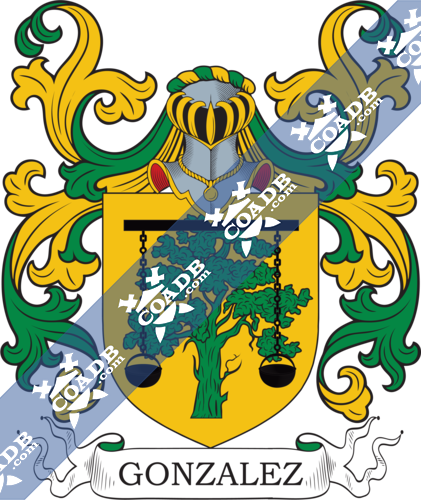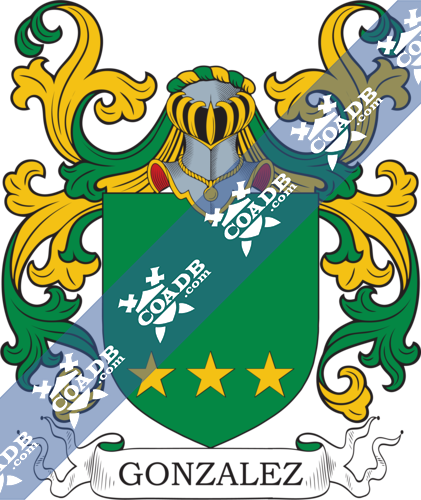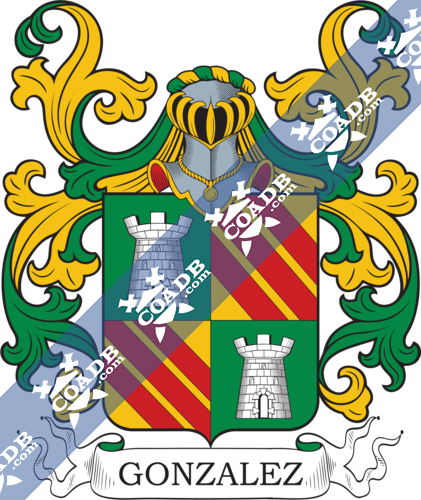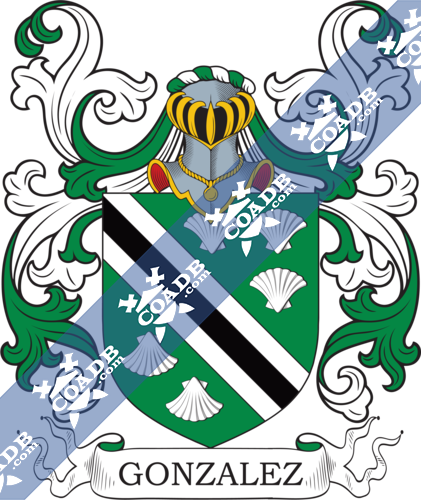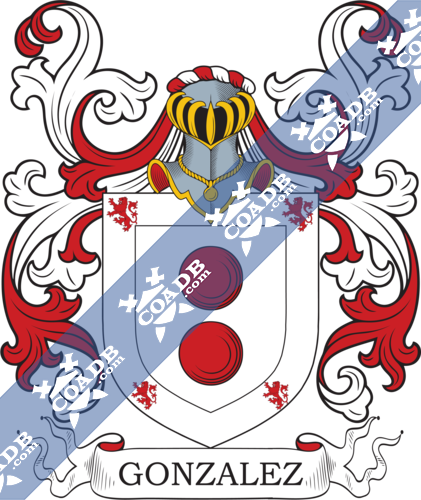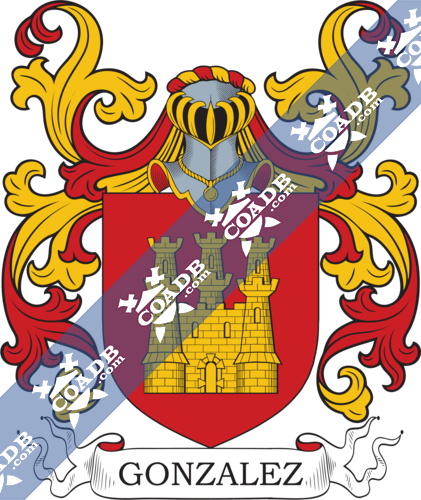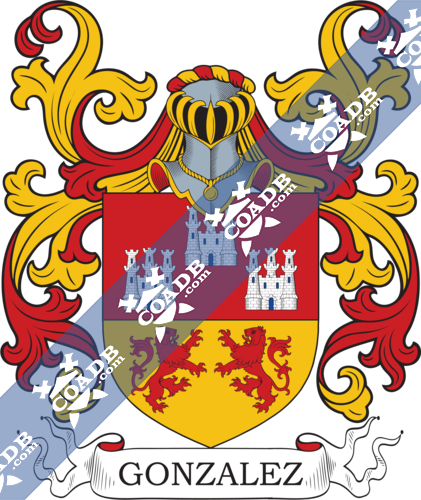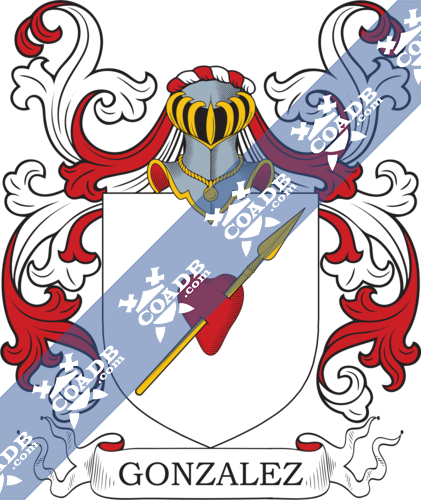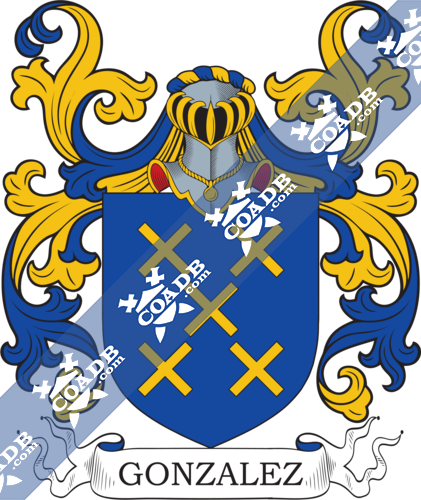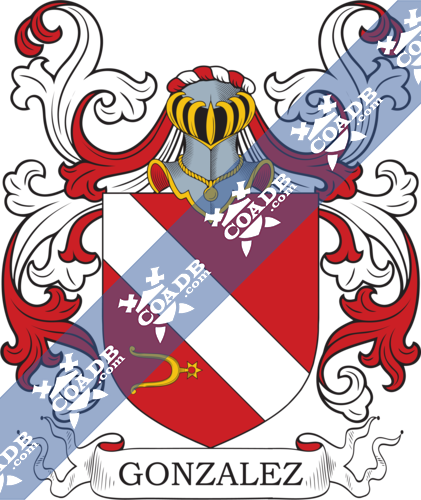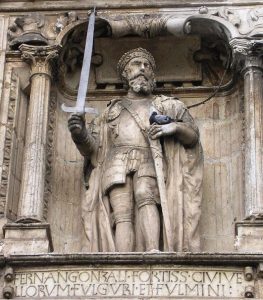Gonzalez Family Crest, Coat of Arms and Name History

Gonzalez Coat of Arms Gallery
Don’t know which Coat of Arms is yours?
We can do a genealogical research. Find out the exact history of your family!
Learn MoreSurname Meaning, Origin, and Etymology
Spain is a country that has spawned many popular surnames, and one that is at the top of that list is Gonzalez. This surname is one of the first examples of hereditary last names due to its patronymic origin. In Spanish, the suffix “ez” gives the surname the meaning of “son of…” similar to the suffix “son” in English, for example, Peterson, which means “son of Peter.” Therefore, the meaning behind Gonzalez is “son of Gonzalo.”

However, as with other surnames from Spain, it has its origins in the Old German language due to the invasion of the Visigoths – a tribe from Eastern Germany – in the Iberian Peninsula during the 5th century. They conquered this territory and brought their culture to these lands while they swept down every society they came across. As result of this conquest, the legacy of the Visigoths can still be seen today through aspects like some last names that people from Spain bear. Etymologically, the surname Gonzalez comes from the Old German word “Gundisalvus,” which can be translated as “the battlefield” or “the battle place.”
Gonzalez is a very common last name in Spain, so after the arrival of Christopher Columbus to America, Spain colonized this new region, bringing many of its names and last names. This is a very common surname in the New World, especially in South America. One of the first records of the Gonzalez surname belongs to Marcos Gonzales de Jungito from Segovia, Spain, who was baptized on July 1, 1556, during the reign of King Philip XI of Spain (1554-1590).
Spelling Variations
Like many other surnames, Gonzalez counts on several spelling variations due to several reasons. Since it is an old Spanish last name that has its origins in a different language, its translation is among those reasons, as well as the mix of languages that was typical during the Middle Age. Another important reason was that during that time, words were written according to their pronunciation, which caused several of them to be written in many different ways while referring to the same name. This phenomenon also happened with surnames, which is why there are variations for Gonzalez like González, Gonzalez, Gundisalvez, Gonsalviz, Gonzálvez, Gonzalvez, Gonçalve, Gonzales, Gonzalo, Gozalo, Monsalve, Monsabre, Gozalvis, Gosalvez, Goçalez, Gunzáloz, Gunzaloz, Galbis, Gálvez, Goncaves, and many others. It is important to note that in Spanish, the accent mark is a way to distinguish two words that are written in the same way, which is why surnames like Gunzálo and Gunzalo, for example, are considered as two different last names.
Popularity & Geographic Distribution
Gonzalez is very popular in more than just one continent. In fact, it is so popular that it is the 62nd most common surname in the world, and it is borne by approximately 6,768,847 people. The country where it is most prevalent is México, and it has its highest density in Cuba. The second country to have the most Gonzalez bearers is Spain, followed by Venezuela in 3rd place of the ranking. This is not rare at all because Spain colonized South America and Central America, and during that time they imposed their culture, names, and surnames to the native people of those continents. All of this data is taken from the census of 2014.
Early Bearers of the Surname
As it is expected, due to the wide reach of this surname, there have been several bearers of the surname Gonzalez throughout history. One of the earliest bearers was Francesco I Gonzaga (1366-1407), who had a variation of the surname and was the leader of Mantua from 1382 until 1407. Others bearers were Maria Gonzales, who on October 3, 1568 got married to Alonzo Moreno at San Sebastian, Spain, and Catharina Martin Gonzalo, who was baptized in Valladolid, Spain on May 7, 1618. In Mexico, there is a record from June 12, 1590 of Francisco Goncalo in Puebla de Zaragoza.
History, Genealogy, and Ancestry
Given its popularity, the surname Gonzalez has several genealogical lines all over the world that are not related to each other. This is a normal for patronymic names. Others are not so easy to trace. Below are some of the most important lines, some of them from Spain, others from Mexico and other countries.
The first line is from Orense, a Spanish city, which became related to the surname Madaleno later on. This line began with Antonio González, who was born in Orense in 1590. He got married to María González in 1620. They had one daughter, Magdalena González, who was born in Puebla de Trives, Orense in 1622. Magdalena married Francisco Rodríguez on September 12, 1647, in Santa María de Torrelobatón. From this last marriage, two children were born: Francisco on July 12, 1651, and Joseph on March 25, 1654. Francisco Madaleno would later marry Catalina de las Queridas in Torrelobatón, and Joseph would later marry Catalina Aparicio.
Another line of González bearers come from the Spanish region of Limpias. These were the González de Haro. The line started with Rodrigo González de Haro, who was born in 1560. He got married to Juana de Lavín de Lombera in 1583. They had four children: María (b. 1584), Pedro (b. 1590), Juan (b. 1592), and another daughter who was also named María (b. 1594). Then, they had another son, Pedro González de Haro, who was born in 1590. He got married to Ysabel de Helguero Rucoba y Espina in San Pedro de Limpias on July 30, 1616. They had three sons: the first one was named Francisco, then came Juan on March 10, 1630, and finally, Diego. Pedro González de Haro died on July 18, 1654.
Juan González de Haro was born in 1630. He got married to María López de Hierro. They had a daughter named Guillerma María González de Haro. Then, Juan got married for a second time to Ana del Castillo Marrón y Alvarado in San Pedro, Limpias on May 18, 1654. Pedro and Ana had three children: Juan Antonio on May 20, 1665, Francisco Antonio on October 17, 1667, and Ana on March 16, 1670. Then Francisco Antonio González de Haro got married to María López de Haro y Haedo Arenas on March 6, 1688. They had nine children, including José Angel on March 19, 1688 and María Francisca on October 15, 1689, who then married Pedro de Matienzo. They also had Manuela Jesús (b. November 22, 1691), Andrés (b. December 8, 1692), who became a priest, Francisco Antonio (b. November 13, 1695), Miguel Antonio (b. October 15, 1697), Gabriel Dionisio (b. 1699), who then became a scribe, Juan Manuel (b. November 27, 1700), who married Clara de Alvarado and also became a scribe, and finally, Ana Paula (b. July 6, 1704).
The fifth son of Francisco Antonio, who was his namesake, got married to María Rosa de Bustillo y Rivas Castillo in Udalla, Cantabria on July 1, 1722. In 1738, they were living in Hoz de Marrón, and they had two children: the first one was born on July 21, 1725 and was named Juan Anselmo, and their second child, named Julián, was born in 1732.
The family continued with Juan Anselmo González de Haro, who was a merchant that married Antonia de Matienzo Martínez Layseca on January 12, 1757. They had five children: Juan José Remigio (b. October 1, 1757), María Ángela (b. March 19, 1762), Matea Antonia (b. October 7, 1764), María Manuela (b. November 13, 1767), and another son named Juan José Remigio (b. May 19, 1770).
The line continued thanks to Juan José Remigio González de Haro, who married Josefa Bayas in Ampuero on July 24, 1786. They had five children: Francisca, who died when she was an infant, Victoriano Francisco on March 23, 1787, who also died very young, Facunda on May 13, 1791, Juana Francisca, who was born on August 18, 1794, and María, who was born on April 12, 1799. Juan José Remigio González de Haro died in Ampuero on March 25, 1831.
This González line continued with the last daughter of Juan José Remigio González de Haro, María González de Haro Bayas, who married Vicente Ruiz on February 4, 1822 in Ampuero. Their children were Manuel, who was born on October 30, 1824, Atanasia, who was born on July 8, 1827, Gregoria who was born on March 13, 1830, Juan Román, who was born on August 19, 1832, and Mateo Cipriano, who was born on August 8, 1837. Throughout the years, the González de Haro line removed the “de Haro” from their surname and only conserved the González surname. This happened with many other surnames from Spain at that time.
There is another line of González bearers from Limpias, who are not related to the González de Haro line. This other line started with María González, who was born in Limpias in 1710 and got married to Francisco de Secadura in 1735. Their daughter was Micaela de Secadura González, who was born in Limpias in 1738 and married Francisco de Múgica de la Fuente in 1765.
Not all lines of González bearers came from Spain. This surname is present in many countries. One of them is Mexico, where we can find another line that began with Pedro González, who was born in Huichiapan, Mexico in 1620. Pedro got married to María Villavicencio in 1648, and they had a daughter, Nicolasa González Villavicencio, who was also born in Huichiapan in 1649. She married José Hernández de Quintanar on November 28, 1666. They had four children: José, Tomás, Cayetano, and Felipe. The record of Felipe shows that he got married to Andrea Pérez de la Paya in San Juan del Río.
Another line of González bearers from Mexico was the González line from Querétaro, which started with Ysabel González, who was born in that city in 1591. She got married to Sebastián Servín in 1613. They had seven children: Juan, who was born on July 6, 1614, Catalina, who was born on August 5, 1616, Francisca, who was born on October 16, 1620, Antonia, who was born on July 10, 1622, Sebastián, who was born on October 5, 1625, and José, who was born on October 17, 1628.
Early American and New World Settlers
After the Europeans found America, a lot of people decided to travel to the New Continent looking for a new life. They arrived with their culture and their surnames, and thus spread these new names. In the case of bearers of the González surname, several of them traveled to South America because this was a colony of Spain, the country from which González originated. It is possible that bearers of this surname traveled with Cristopher Columbus, but there are no records of them. The existent records show that during the 16th century some of the González bearers who reached in America were Martín González, who arrived in Paraguay in 1540, Pedro González de Prado, who got to Chile in that same year, Francisco González, who arrived to Nicaragua in 1562, Andrea González, who reached Peru also in 1562, and in that same year, Diego González arrived to Hispaniola.
During the 19th century, other González bearers arrived in the United States, such as Bernardo Gonzales, who reached Puerto Rico in 1803 and Pedro Gonzalez, who landed in America in 1811. The following year Leonor González would arrive in America, and in 1814, Macias Gonzalez and Bartolome Gonzalez did the same.
Mottoes
We were unable to locate any documented mottoes for the González family.
Grantees
We were unable to locate any documented grantees for the González family.
Notables
There have been several bearers of the González surname who have played a key role in different fields. Some of them are Freddy Gonzalez (b. 1977), a long-distance runner from Venezuela, Ángel Gonzalez (b.1925) a Spanish poet, and Luis Eduardo González (1945-2016), an Uruguayan who played an important role in different areas like politics, science, and sociology. There other notable bearers of this surname, such as Raúl González (b. 1977), an renowned Spanish football player, Carlos González (b.1985), a baseball player from Venezuela, Rubén González (1919-2003), a Cuban Pianist, and Alejandro González Iñárritu (b. 1963), a notable filmmaker from Mexico.
Blazons & Genealogy Notes
2) Hainaut – (Nob. du St.-Empire, 25 fév. 1736) – De gueules à la fasce d’argent acc en chef de deux lions d’or tenant chacun une épée du second et en pointe d’un château aussi d’argent Casque couronné Cimier un lion de l’écu issant Lambrequin d’argent et de gueules Supports deux griffons d’or. English: Gules a fess argent accompanied by in chief by two lions or each having a sword of the second and in base a castle also argent Crowned with a helmet Crest: a lion of the shield issuant Mantling: argent and gules Supporters two griffins or.
3) Gonzalès de Aveldas – Espagne, Artois – D’azur à un chêne de sinople terrassé du même accosté au pied de deux tourterelles affrontées au naturel becquées et membrées de gueules. English: Azure with an oak vert on a mount of the same accompanied by at the foot by two (turtle) doves affrontant [face to face] proper beaked and legged gules.
4) Gonzalès de Saldagne – Brabant – D’azur à deux lions affrontés d’or supportant de leurs pattes une tour du même et soutenu d’un tertre d’argent à la bordure engrelée d’or. English: Azure two lions affrontant [face to face] or supporting on their paws a tower of the same and standing on a hillock argent a bordure engrailed or.
5) Royaume de Valence – D’argent à deux tourteaux de gueules l’un sur l’autre à la bordure du premier ch de quatre lions du second posés dans les cantons. English: Argent two roundels gules in pale a bordure of the first charged with four lions of the second placed in the quarters.
6) Mayorque – (Bover) – Écartelé aux 1 et 4 de gueules à une tour d’argent sommée sur le crénelage à senestre d’une bannière du même aux 2 et 3 d’or au lion rampant de gueules soutenu de trois pointes d’azur mouvant de la pointe. English: Quarterly 1st and 4th gules with a tower argent surmounted by over the battlements to the sinister a square flag of the same 2nd and 3rd or of lion rampant gules supported by three points azure coming out of the base.
7) Castille – De gueules à une tour sommée de trois tourelles d’or celle du milieu plus élevée. English: Gules with a tower surmounted by three turrets or that of the middle the highest.
8) Gonzalez de Andia – Guipuzcoa – Parti au 1 de gueules à une tour sommée de trois tourelles d’or celle du milieu plus élevée au 2 d’argent au lion de gueules couronné d’or. English: Per pale 1st gules with a tower surmounted by by three turrets or that of the middle the highest 2nd argent a lion gules crowned or.
9) de La Pezuela – Comte de Cheste – Castille – (Comte, 2 déc. 1838) – De gueules à la bande d’argent acc en pointe d’un éperon d’or posé en fasce la molette à senestre Supports deux hermines au naturel Devise POTIUS MORI QUAM FOEDARI. English: Gules a bend argent accompanied by in base a spur or placed fesswise the mullet to the sinister Supporters two ermines (stoats) proper Motto: POTIUS MORI QUAM FOEDARI.
10) Gonzalez del Campillo – Royaume de Léon – Parti au 1 de gueules à trois colonnes d’or rangées en fasce au 2 d’argent à un arbre terrassé de sinople acc de quatre étoiles (8) d’or 2 en chef et 2 accostant le fût. English: Per pale 1st gules three columns [pillars] or arranged fesswise 2nd argent with a tree on a mount vert accompanied by four etoiles of 8 points or 2 in chief and 2 either side of the trunk.
11) Gonzalez de Mena – Asturies – Parti au 1 d’argent à un arbre de sinople acc de trois loups de sable passants derrière le fût l’un sur l’autre et accosté de deux chaudières de sable suspendues aux branches au 2 reparti d’argent à deux loups passants de sable l’un sur l’autre et d’or à deux chaudières de sable l’un sur l’autre et à la bordure de gueules ch de huit flanchis d’or 1 en chef 3 à chaque flanc l’un sur l’autre et 1 en pointe. English: Per pale 1st argent with a tree vert accompanied by three wolves sable passant behind the trunk in pale and having to the sides two cauldrons sable suspended from the branches 2nd also per pale argent two wolves passant sable in pale and or two cauldrons sable in pale and a bordure gules charged with eight saltorels or 1 in chief 3 in each flank in pale and 1 in base.
12) Gonzalez de Sepulveda – Castille – Écartelé au 1 de sinople à la croix florencée d’or vidée du champ au 2 de gueules à une tour de deux étages d’or sommée d’un senestrochère armé d’argent brandissant une épée au 3 d’azur au lion d’or au 4 d’azur à cinq fleurs-de-lis d’or 2 1 et 2 L’écu entouré d’une bordure de gueules ch de huit flanchis d’or alternant avec huit mouchetures d’hermine d’argent les deux du chef couchées et affrontées les deux de la pointe couchées et opposées. English: Quarterly 1st vert with the cross florey or voided of the field 2nd gules with a tower of two levels or surmounted by a left arm armoured argent brandishing a sword 3rd azure a lion or 4th azure with five fleur de lys or 2 1 and 2 the shield surrounded by a bordure gules charged with eight saltorels or alternatively with eight ermine tails argent the two of the chief laying on the ground and affrontant [face to face] the two of the base laying on the ground and opposing.
13) Gonzalez de Villalba – Andalousie – Écartelé au 1 d’or à une aigle de sable à la bordure du premier ch sur chaque flanc d’une main de carnation empoignant deux clés de sable passées en sautoir au 2 d’or à une tour donjonnée au naturel sommée d’une tête de lion de gueules couronné d’or et quatre drapeaux d’argent mouv des créneaux de la tour à la bordure de gueules ch de huit flanchis d’or au 3 d’azur à une tour donjonnée d’or surmontée de sept étoiles (8) du même rangées en demi-cercle au 4 de gueules à la bande d’or engoulée de deux têtes de dragon de sinople et à la bordure aussi de sinople ch des mots AVE MARIA GRATIA PLENA en lettres d’or. English: Quarterly 1st or with an eagle sable a bordure of the first charged with over each flank a hand carnation holding in its fist two keys sable placed saltirewise 2nd or with a tower turreted proper surmounted by a head of lion gules crowned or and four flags argent coming from the merlons (battlements) of the tower a bordure gules charged with eight saltorels or 3rd azure with a tower turreted or surmounted by seven etoiles of 8 points of the same arranged in a semi circle 4th gules a bend or being swallowed by two dragon’s head vert and a bordure also vert charged with the words AVE MARIA GRATIA PLENA in letters or.
14) Gonzalez Grano de Oro – Royaume de Léon – Parti au 1 d’or à la fasce de sinople au lion rampant au naturel brochant sur le tout au 2 de gueules à deux ours passants d’or l’un sur l’autre surmontés de deux colombes accostées d’argent. English: Per pale 1st or a fess vert a lion rampant proper covering overall 2nd gules two bears passant or in pale surmounted by two doves side by side argent.
15) Algunos de Castilla, traen: En campo de oro, un árbol de sinople y, brochante sobre el todo, un palo que atraviesa el árbol por la copa, y de cada punta del palo pende una caldera de sable. English: Or, a tree vert, above a stick that crosses the tree at treetop and from each tip of the stick hangs a cauldron sa.
16) Otros de Castilla, traen: En campo de gules, un castillo de oro y, debajo de él, una llave del mismo metal. English: Gu., a castel or, below it a key of the same.
17) Los originarios de Matallana (León) y radicados en Valladolid y Zamora, traen: En campo de oro, cinco banderas de gules, puestas dos, dos y una, cargada cada una de ellas de un creciente de plata. English: Or, five flags gu., arranged 2,1,2, each charged with a crescent ar.
18) Los de Luarca, traen: En campo de oro, una banda de gules (armas del Conde Fernán-González). English: Or, a bend gu.
19) Los de Asturias, traen: En campo de plata, una flor de lis de azur, acompañada de cuatro rosas al natural. English: Ar., a fleur de lis az. accompanied by four roses ppr.
20) Los de la merindad de Trasmiera, traen: En campo de sinople, un castillo, de oro, aclarado de azur. English: Vert, a castle or, openings az.
21) Los de Granada, traen: En campo de plata, una faja de sinople, acompañada en lo alto de un león de gules. English: Ar, a fesse vert, in chief a lion gu.
22) Los de León, traen: En campo de sinople, cinco herraduras de plata, con bullones de sable, puestas en sotuer. English: Vert, five horseshoes ar, holes sa., saltirewise.
23) Los de Cartagena (Murcia), traen: En campo de sinople, una hebilla, redonda, de oro; el jefe de gules, con un águila de sable. English: Vert, a round buckle or, in chief gu.an eagle sa.
24) Los de Benavente (Zamora), traen: En campo de sinople, en punta, tres estrellas de oro, puestas en faja. English: Vert, in base three stars, fessewise.
25) Los de Salamanca, traen: En campo de plata, tres hebillas de azur, bien ordenadas. English: Ar, three buckles az., well ordered (2,1)
26) Otros traen: En campo de plata, una faja, de gules, acompañada de dos abarcas, de sable. English: Ar, a fesse gu., accompanied by two sandals sa.
27) Otros de León y Zamora, traen: En campo de sinople, en punta un castillo de oro, sobre él dos lises del mismo metal, una a cada flanco, en jefe un águila también de oro; bordura de oro, con ocho sotueres de gules. English: Vert, in base a castle or, two fleur de lis in each flank, in chief and eagle of the same, all within birdure also or charged with eight saltires gu.
28) Otros de León, traen: En campo de azur, tres árboles de oro, en faja, frutados de gules. English: Az., three trees or, fessewise, fructed gu.
29) Otros de Castilla, traen: En campo de oro, cuatro espigas de grano, de sinople. English: Or, four ears of wheat vert.
30) Otros traen: En campo de sinople, un puente de oro, sobre ondas de azur y plata, sumado de una torre y esta de una bandera, de azur. English: Vert, a bridge or on a waves of az.and ar., added a tower and a flag of the second.
31) Los de Calatayud (Zaragoza), traen: En campo de plata, un castillo ardiendo, de gules. English: Ar, a castle ina fire, gu.
32) Otros de Sevilla, traen: En campo de oro, una iglesia, de sable, acompañada de dos cipreses, de sinople. English: Or, a church sa, accompanied by two cypresses vert.
33) Los de Cataluña, traen: En campo de plata, un lebrel, de su color, manchado de sable, y en su boca, un ave. English: Ar,a greyhound ppr, spotted sa., in his mouth a bird.
34) Los de Venezuela, traen: En campo de azur, sembrado de lises; bordura de oro, con ocho aspas, de plata. English: Az., semmee de lis or. within bordure of the last charged with eight saltires ar.
35) Otros de Castilla, traen: En campo de plata, tres águilas pasmadas, de sable English: Ar, three eagles (…?) sa.
36) Otros de Granada, traen: Escudo cuartelado: 1º y 4º, en oro un león, de púrpura, y 2º y 3º, en plata, tres espadas, en palo, de sable. English: Quaterly, 1st and 4th, Or a lion purp., 2nd and 3rd Ar, three swords in pale sa.
37) Otros de Andalucía, traen: Escudo partido: 1º, en gules, un castillo, de oro, y 2º, en plata, un león rampante, de púrpura. English: Per pale, 1st Gu, a castle or, 2nd Ar, a lion rampant purp.
38) Los de Aragón, traen: En campo de oro, cinco calderas, de sable, jaqueladas, de gules. English: Or, five cauldrons checky sa. and gu.
39) Los de Trujillo, El Perú, traen: Escudo partido: 1º, en gules, un castillo, de oro, mazonado, y 2º, en plata, un león rampante, de gules. English: Per pale, 1st Gu, a castle or, 2nd Ar, a lion rampant gu.
40) Otros de Castilla, traen: Escudo partido: 1º, en campo de gules, un castillo, de oro, almenado, aclarado de sable, y 2º, ajedrezado de quince piezas, ocho de azur, y siete de oro. English: Per pale, 1st Gu, a castle or, 2nd checkered in 15 pieces, 8 az.and 7 or.
41) Otros traen: Escudo partido: 1º, en gules, una torre almenada, de plata, y 2º, en gules una banda, del mismo metal. English: Per pale, 1st Gu, a castle ar., 2nd Gu, a bend ar.
42) Los de Cangas de Onís, traen: En campo de gules, un castillo de plata, y en su torre del homenaje un león rampante, de oro English: Gu., a castle ar, and on his highest tower a lion rampant or.
43) Los de Corvera, Asturias, traen: Escudo cuartelado: 1º y 4º, de sinople, con un castillo de plata, y 2º y 3º, de oro, con tres bandas de gules. English: Quaterly, 1st and 4th, Vert, a castle ar., 2nd and 3rd Or, three bends gu.
44) Los de Corvera, Asturias, también traen: Escudo cuartelado: 1º y 4º, de sinople, con una torre de plata, y 2º y 3º, de oro, con tres bandas de gules. English: Quaterly, 1st and 4th, Vert, a tower ar., 2nd and 3rd Or, three bends gu.
45) Los de Santander, traen. En campo sinople, una banda de plata, cargada con una cotiza de sable y acompañada de cinco veneras de plata, tres en lo alto y dos en lo bajo. English: Vert, bend ar, charged with bendlet sa., accompanied by five escallops, three in chief and two in base.
46) Los de Santander, también traen. En campo sinople, una banda de oro, cargada con una cotiza de sable y acompañada de cinco veneras de plata, tres en lo alto y dos en lo bajo. English: Vert, bend or, charged with bendlet sa., accompanied by five escallops, three in chief and two in base.
47) Los de Villanueva de Cameros, La Rioja, traen: En campo de oro, un pino de sinople y un león pasante de gules, atado al tronco, con cadena, de azur. English: Or, a pine tree vert and a lion passant gu, chained az, on a trunk.
48) Otros de Castilla la Vieja, traen: Escudo cortado: 1º, de gules con cinco jazmines de plata, puestos en sotuer, y 2º, de azur, con siete estrellas de plata, puestas tres, tres y una. English: Per fesse, 1st Gu, five jasmines ar., saltirewise, 2nd Az., seven stars ar., arranged 3,3,1.
49) Los de Pola de Gordón, León, traen: En campo de azur, cinco leones de oro puestos en sotuer; bordura de plata, con ocho árboles de sinople, arrancados. English: Az, five lions or, saltirewise, within bordure ar., charged with eight trees eredicted vert.
50) Otros traen: En campo de plata, seis rosas, de gules, puestas en dos palos, en punta, tres cabezas de moro, al natural, puestas en faja. English: Ar., six roses gu., arranged in two palets, in base three Moors heads pr, fessewise.
51) Otros en el reino de León, traen: Escudo partido: 1º, en campo de plata, cinco flores de lis, de azur, puestas en sotuer, y 2º, de gules, con una cruz floreteada de oro, medio cortado de sinople, con un castillo, de oro. English: Per pale, 1st Ar, five fleur de lis az.saltirewise, 2nd Per fesse, Gu, a cross flory or, and Vert, a castle or.
52) Otros también de León, traen: Escudo partido: 1º, de gules, con un castillo de oro, medio cortado de este metal, con un puente de dos arcos, de piedra, sobre un río, y 2º, de plata, con un águila, de sable. English: Per pale, 1st per fesse, Gu, a castle or and Or, with stone bridge with two arcs over the river. 2nd Ar, an eagle sa.
53) Los de Fresno de Cantespino, Segovia, después extendidos por Andalucía, traen: Escudo partido: 1º, en gules, un castillo, de oro, aclarado de azur, y 2º, de gules, con una banda de plata. English: Per pale, 1st Gu, a castle or, openings az., 2nd Gu, a bend ar.
54) Los de Medina de Pomar, Burgos, traen: Escudo cuartelado: 1º y 4º, de oro, con un león rampante de su color, y 2º y 3º, de gules, con un sotuer de oro. English: Quaterly, 1st and 4th Or, a lion rampant ppr., 2nd an 4th, Gu, a saltire or.
55) Los de Aguilar de Campoo, Palencia, traen: En campo de azur, un lucero de oro. English: Az, a star or.
56) Otros en Castilla, traen: Escudo cuartelado: 1º y 4º, en gules, con un castillo, de plata, que tiene en su torre del homenaje una bandera de sinople con el asta de oro, 2º y 3º, de oro, con un león rampante, de azur; y entado en punta, de plata, con tres chevrones de sinople. English: Quaterly, 1st and 2nd, Gu., a castle ar. Which has in its highest tower a flag vert, with flagpole or., 2nd and 3rd Or, a lion rampant az., and set in tip (base) Ar, a three chevrons vert.
57) Otros de Castilla, traen: Escudo cortado: 1º, en campo de gules, dos castillos de plata, aclarados de azur, puestos en faja y sumado su torre del homenaje de un estandarte de plata con asta de oro, y 2º, de oro, con dos leones de sable rampantes y afrontados, y en punta tres chevrones de azur. English: Per fesse, 1st Gu, two castles ar, openings az, fessewise, on highest tower of each castle a standart ona pole or., 2nd Or, Two lions combatant sa., in base three cevrons az.
58) Otros de Madrid, traen: Escudo cuartelado: 1º, de plata, con cinco flores de lis de azur puestas en sotuer, 2º, también de plata, con una cruz vana y floreada, de gules, 3º, de plata, con un león rampante de púrpura, armado y lampasado de gules, y 4º, de oro, con un castillo de piedra; bordura general de gules, con ocho sotueres de oro y ocho armiños de sable, alternando. English: Quaterly, 1st Ar, a five fleur de lis az, saltirewise, 2nd Ar a cross flory voided gu., 3rd Ar, a lion rampant purp, armed and langued gu., 4th Or, a castle ppr, all within bordure gu, charged with eight saltires or and eight ermine spots sa., alternately.
59) Los de Villanueva de los Escuderos, en Cuenca, traen: Escudo partido: 1º, en campo de plata, un león rampante de sable, y 2º, de oro, con tres fajas de gules y entre ellas catorce armiños de sable, colocados tres, cuatro, cuatro y tres. English: Per pale, 1st Ar, a lion rampant sa., 2nd Or, three bars gu. And among them 14 ermine spots in order 3,4,4,3.
60) Otros también de Castilla, traen: Escudo jaquelado de azul y oro; bochante sobre el todo una faja de gules, y seis hojas de higuera de su color puestas a modo de orla. English: Checky az and or, a bend gu, six leaves of fig ppr arranged in orle.
61) Los de Osuna, en Sevilla, traen: En campo de plata, dos pinos de sinople frutados de oro; bordura de oro con cuatro lobos , de sable. English: Ar, two pine trees vert fructed or, within bordure of the last charged with four wolves sa.
62) Los de Vélez-Rubio, en Almería, traen: Escudo cuartelado: 1º y 4º, de gules, con un castillo de oro, y 2º y 3º, también de gules, con dos palos de oro. English: Quaterly, 1st and 4th Gu, a castle or, 2nd and 3rd, Gu, two pales or.
63) Otros de Aragón, traen: En campo de plata, un águila de sable, picada y membrada de oro. English: Ar, an eagle sa, beaked and legged or.
64) Otros de Aragón, traen: En campo de azur, cuartelado por un sotuer de oro, 1º, en águila de oro, 2º y 3º, una flor de lis del mismo metal, y 4º, un castillo también de oro; bordura de este metal con ocho sotueres, de gules. English: Az, saltire or, in chief an eagle, in each flank a fleur de lis and in base a castle all of the last, all within bordure of the same charged with eight saltires gu.
65) Otra versión del mismo escudo: Cuartelado por un sotuer de oro, 1º, de plata, un águila de sable, 2º y 3º, de azur, con una flor de lis de, oro y 4º de sinople, con un castillo, de oro; bordura general de oro, con seis sotueres de gules, tres a cada lado. English: Per saltire in chief ar an eagle sa, in base vert a castle or and in each flank az a fleur de lis or, over division a saltire of the last., all within bordure of the same charged with six saltires gu., three on each side.
66) Otros traen: En campo de oro, un águila de sable, perfilada de gules y surmontada de una estrella, de oro; brochante sobre el todo una faja, de plata. English: Or, an eagle sa. profiled gu., surmounted by star of the first, over all a fesse ar.
67) Los de Murcia, traen: En campo de plata, un castillo de gules y dos leones empinados en sus muros; bordura de azur con ocho armiños de sable, fileteados de oro. English: Ar, a castle gu., two lions gu, steep on their walls, within bordure az, charged with eight ermine spots sa., profiled or.
68) Los de Villavieja del Cerrato, en Valladolid, luego extendidos a Vitoria y San Sebastián, traen: En campo de azur, una banda de plata. English: Az, a bend ar.
69) Los de Briones, La Rioja, traen: En campo de plata, un estandarte de azur, cargado de una cruz, de oro. English: Ar., a a standart az charged witha cross or.
70) Los de Almazán, en Soria, traen: En campo de azur, medio vuelo, de oro; bordura de plata, con una cadena de azur. English: Az, a wing or, within bordure ar charged with chain of the first.
71) Los de Navarra traen: En campo de azur, cinco castillos, de oro, puestos en sotuer. English: Az, five castles or, saltirewise.
72) Otros de Galicia, traen: En campo de gules, un castillo de plata, aclarado de azur, y un león rampante, de oro, coronado de lo mismo, abrazando el castillo con ambas manos. English: Gu, a castle ar, openings az., and a lion rampant or., crowned of the same, hugging a castle by his paws.
73) Otros de Galicia, traen: Escudo cortado: 1º, en campo de gules, tres castillos de plata aclarados de azur, mal ordenados, y 2º, en campo de oro, dos leones, de gules, enfrentados. English: Per fesse, 1st Gu, three castles ar, openings az., bad ordered (1,2), 2nd Or, two lions combatant gu.
74) Otros de Galicia, traen: En campo de sinople, una banda de azur, perfilada de oro, acompañada de seis veneras de plata, tres en lo alto y tres en lo bajo, bien ordenadas. English: Vert, a bend az., profiled or, accompanied by sic escallops ar, three in chief and three in base.
75) Otros de Galicia, traen: En campo de plata, un pino de sinople, con dos lebreles empinados sobre él, y superado de una cruz simple, de gules. English: Ar., a pine vert, with two greyhounds steep on it, surmounted by a simple cross gu.
76) Los del País Vasco, traen: En campo de plata. una panela, de oro, atravesada de una lanza, de oro. English: Ar., a leaf of tilia or pierced of a spar of the same.
77) Radicado en Peñacerrada y extendido a Madrid, traen: Escudo partido: 1º, en gules, dos calderas de oro, 2º, de plata, cinco hoces de azur, encabadas de sable. English: Per pale, 1st Gu, two cauldrons or, 2nd Ar, five sickles az, hilted sa.
78) Los de México, traen: En campo de azur, dos águilas volantes, de oro. English: Az., two eagles volant or.
79) Los de Lima, El Perú, traen: En campo de plata, tres arcabuces, de sable, puestos en faja; bordura de azur, con tres veneras, de oro, puestas en jefe. English: Ar, three arcabuses sa, fessewise, within bordure az, charged in chief with three escallops or.
80) Los de Ager, Lérida, pasados a México, traen: En campo de plata, cinco águilas, de sable, puestas en aspa. English: Ar., five eagles sa. Arranged on the edge (?)
81) El Emperador D. Carlos I concedió, por privilegio dado en Madrid a 5 de septiembre de 1530, el siguiente escudo de armas a D. Rui González, vecino de Tenochtitlán (México); escudo de oro, partido por un palo de gules; siniestrado de un puente sobre una acequia con agua, y adiestrado de un águila, de sable, rampante; bordura de plata, con ocho cruces de gules. English: Or, divided by palets gu., sinister, a bridge over a ditch with water, dexter an eagle rampant sa., all within bordure ar, charged with eight crosses couped gu.
82) Los de Conforcas, en León, traen: En campo de gules, una banda, de oro, acompañada en lo alto de una estrella de plata y en lo bajo, de un corazón, de oro. Radicado en Cuba, de D. Pedro González Quevedo, vecino de Camaguey, Cuba. English: Gu, a bend or, accompanied in chif by star ar, and in base by heart of the second.
83) Originario de Carasa: En campo de azur, cinco aspas, de oro, puestas en aspa. English: Az, five saltires or, arranged in saltire.
84) Otros de Galicia: En campo de gules, un castillo de oro, aclarado de azur, con un mote en letras de oro, en la bordura de azur, que dice: “De los reyes godos sales, apellido de Gonzales”. English: Gu, a castle or with openings az., within bordure of the last charged with motto ”De los reyes godos sales, apellido de Gonzales”, letter or.
85) Radicado en Villanueva de la Nia: En campo de plata, un sable, de oro, encabado de sable. English: Ar, a sabre or, hilted sa.
86) Vecino de Villanueva de la Serena: En campo de plata, armiñado de sable. English: Ermine






